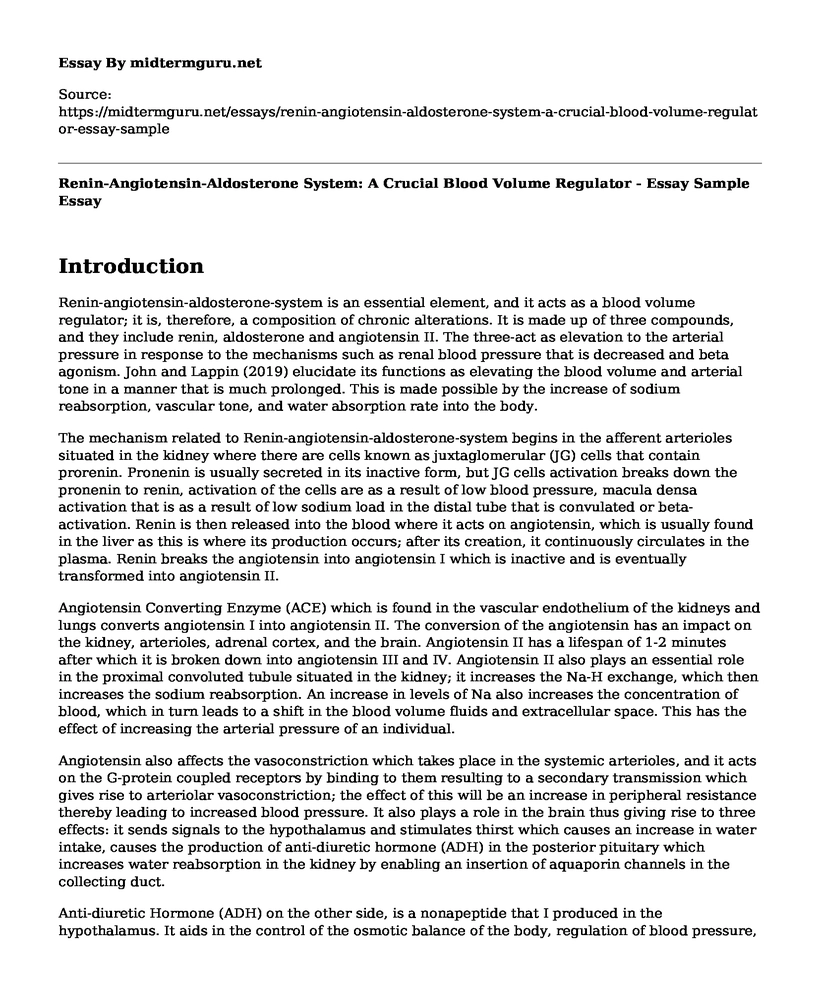Introduction
Renin-angiotensin-aldosterone-system is an essential element, and it acts as a blood volume regulator; it is, therefore, a composition of chronic alterations. It is made up of three compounds, and they include renin, aldosterone and angiotensin II. The three-act as elevation to the arterial pressure in response to the mechanisms such as renal blood pressure that is decreased and beta agonism. John and Lappin (2019) elucidate its functions as elevating the blood volume and arterial tone in a manner that is much prolonged. This is made possible by the increase of sodium reabsorption, vascular tone, and water absorption rate into the body.
The mechanism related to Renin-angiotensin-aldosterone-system begins in the afferent arterioles situated in the kidney where there are cells known as juxtaglomerular (JG) cells that contain prorenin. Pronenin is usually secreted in its inactive form, but JG cells activation breaks down the pronenin to renin, activation of the cells are as a result of low blood pressure, macula densa activation that is as a result of low sodium load in the distal tube that is convulated or beta-activation. Renin is then released into the blood where it acts on angiotensin, which is usually found in the liver as this is where its production occurs; after its creation, it continuously circulates in the plasma. Renin breaks the angiotensin into angiotensin I which is inactive and is eventually transformed into angiotensin II.
Angiotensin Converting Enzyme (ACE) which is found in the vascular endothelium of the kidneys and lungs converts angiotensin I into angiotensin II. The conversion of the angiotensin has an impact on the kidney, arterioles, adrenal cortex, and the brain. Angiotensin II has a lifespan of 1-2 minutes after which it is broken down into angiotensin III and IV. Angiotensin II also plays an essential role in the proximal convoluted tubule situated in the kidney; it increases the Na-H exchange, which then increases the sodium reabsorption. An increase in levels of Na also increases the concentration of blood, which in turn leads to a shift in the blood volume fluids and extracellular space. This has the effect of increasing the arterial pressure of an individual.
Angiotensin also affects the vasoconstriction which takes place in the systemic arterioles, and it acts on the G-protein coupled receptors by binding to them resulting to a secondary transmission which gives rise to arteriolar vasoconstriction; the effect of this will be an increase in peripheral resistance thereby leading to increased blood pressure. It also plays a role in the brain thus giving rise to three effects: it sends signals to the hypothalamus and stimulates thirst which causes an increase in water intake, causes the production of anti-diuretic hormone (ADH) in the posterior pituitary which increases water reabsorption in the kidney by enabling an insertion of aquaporin channels in the collecting duct.
Anti-diuretic Hormone (ADH) on the other side, is a nonapeptide that I produced in the hypothalamus. It aids in the control of the osmotic balance of the body, regulation of blood pressure, and efficient kidney function. ADH binds to the V receptors on the principal cells which are connected to G. The binding leads to activation of G of adenylate cyclase which then leads to an increase in messenger cyclic (AMP), AMP sees to it that protein kinase A is activated. Finally, there is the phosphorylation of the intracellular aquaporin-2 storage vesicles; this process makes their movement into the apical membrane flexible. The intracellular aquaporin is a channel that allows the flow of water into the cell by the guidance of osmotic gradient, thereby promoting water absorption in the kidney. (Cuzzo & Lappin, 2019)
Situations of chronic heart failure are as a result of activation of neurohormonal and autonomic control alterations, which includes sympathetic tones that are heightened in nature and activation of the RAAS. Despite the neurohormonal mechanisms being a pillar to the heart in standard physiological instances, they also lead to progressed heart failures in certain circumstances.
In times of heart failure by a patient, the renin-angiotensin-aldosterone-system is stimulated, the stimulation leads to an increase in the concentration of renin, angiotensin II, plasma, and aldosterone. Angiotensin II is a vasoconstrictor and systemic circulation, and it does the following: releases noradrenaline enables inhibition of vagal tone and promotes the production of aldosterone. The following steps led to sodium and water retention and increased the production of potassium. In connection to this, angiotensin II impacts on cardiac myocytes, which may lead to endothelial dysfunction that is often present in chronic heart failure.
RAAS is also activated by the sympathetic nervous system, which is usually activated during heart failure. It is mainly enabled by the sustained sympathetic simulation, which leads to increased levels of venous and arterial tone, salt, water, and oedema retention. The Anti-diuretic Hormones also play a role in times of heart failure; their concentrations are typically increased, especially in chronic heart failure. The high concentration of the hormone is often associated with patients who are explicitly receiving diuretic treatment, a factor that may lead to the formation of hyponatremia.
Reference
Fountain, John, Lappin, Sarah. (2019). Physiology, Renin Angiotensin System. Retrieved on May 24, 2019, from https://www.ncbi.nlm.nih.gov/books/NBK470410/
Cuzzo, Brian, Lappin, Sarah. (2019). Vasopressin (Antidiuretic Hormone, ADH). Retrieved on May 24, 2019 from https://www.ncbi.nlm.nih.gov/books/NBK526069/
Cite this page
Renin-Angiotensin-Aldosterone System: A Crucial Blood Volume Regulator - Essay Sample. (2023, Jan 14). Retrieved from https://midtermguru.com/essays/renin-angiotensin-aldosterone-system-a-crucial-blood-volume-regulator-essay-sample
If you are the original author of this essay and no longer wish to have it published on the midtermguru.com website, please click below to request its removal:
- Essay on New Drug for the Treatment of Lewy Body Dementia
- Essay on Stress Biomarkers: Salivary Cortisol
- Do Nurses Get Paid Enough? - Research Paper
- Research Paper on Sleep Deprivation
- Essay Sample on Theme of AIDS in Movies: Dallas Buyers Club and the Philadelphia
- Telehealth and the Role of Nurses in Strengthening Healthcare Infrastructure - Essay Sample
- Spinal Cord Gates: Unlocking Pain's Secrets - Essay Sample







